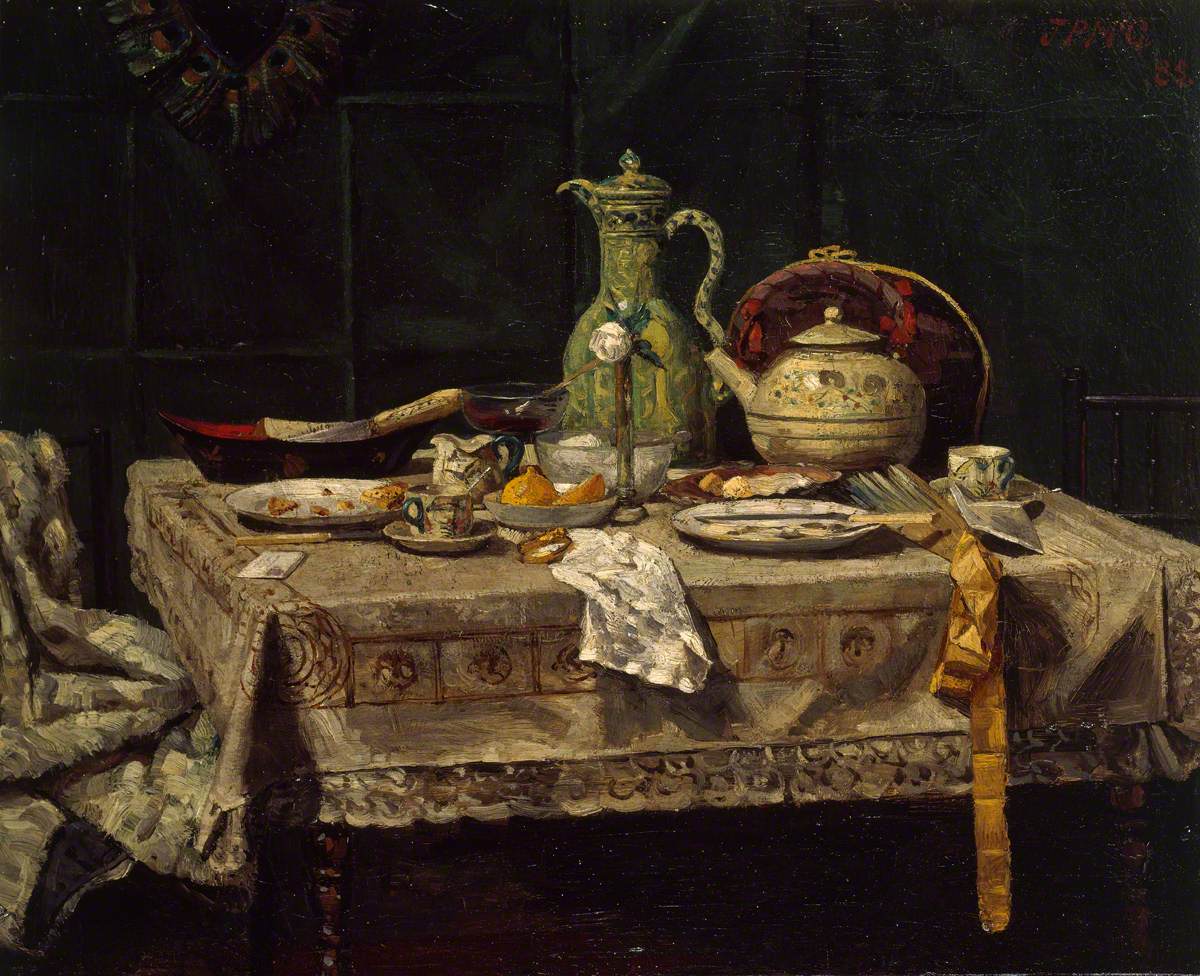
By Staff Middle Land
by Anne Wallentine
To dunk or not to dunk, that is the question.
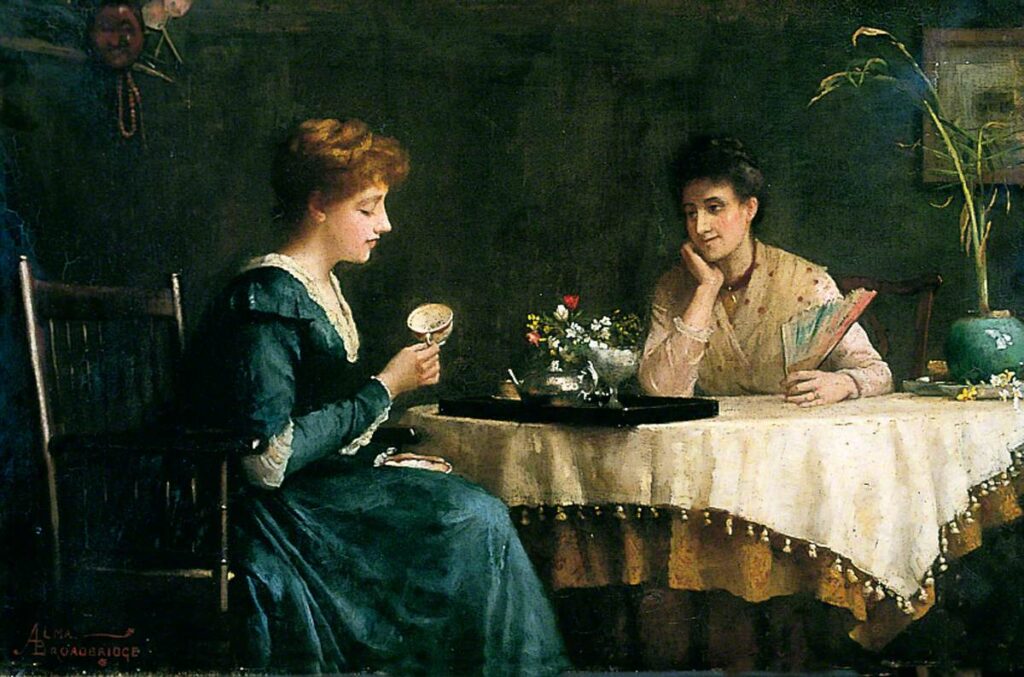
Tea is quite a conundrum:
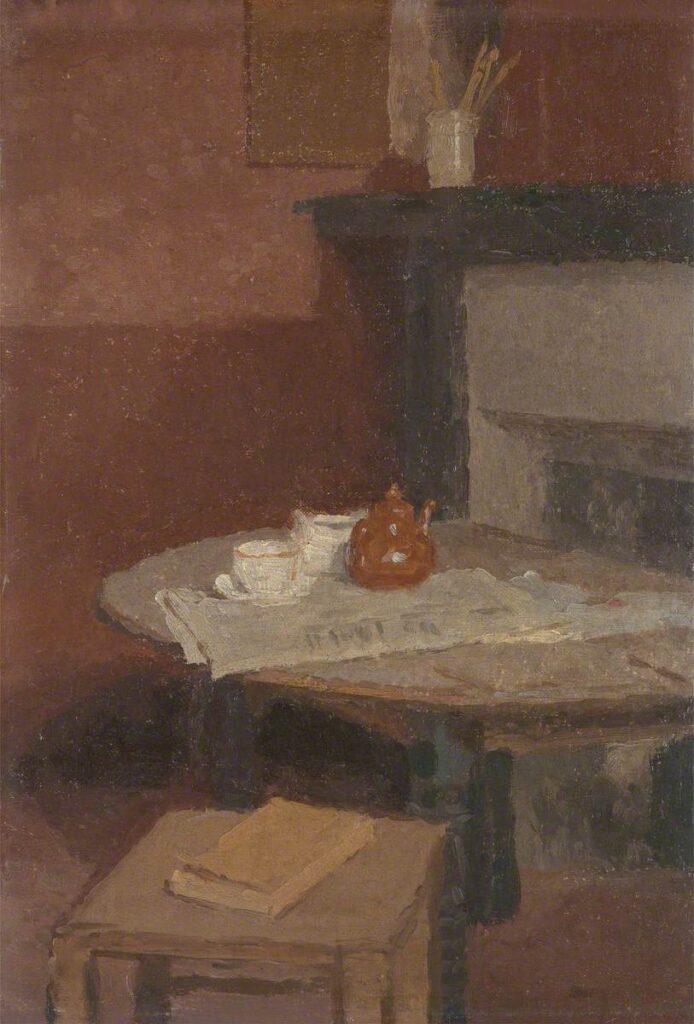
it is an uplifting social drink that has caused all manner of chaos,from devastating colonial exploitation to mere ‘violent disputes’ over its brewing methods, as George Orwell wrote.
Tea fuelled centuries of imperial expansion, exploitation and industrialisation. But, cup by cup, it has also facilitated social unity and compassion (or at least offered a solution to any awkward dilemma).
Because of these economic and social effects, the UK remains one of the top tea-consuming countries, downing approximately 100 million cups each day. Depictions in art and advertisements show how tea has become intertwined with British history and identity, uniting consumers in a shared national story while distinguishing social values in the many methods of sharing a cup.
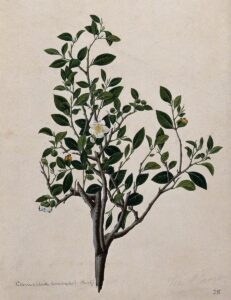
What is tea?
As shown in this botanical drawing, the tea plant (Camellia sinensis) produces flowers, but its leaves are used to produce the drink. They are withered, dried, and oxidised in different ways to create the varied kinds of tea we know today. Tea naturally contains caffeine, which stimulates energy, and tannins, whose antimicrobial properties may have contributed to tea’s early medic
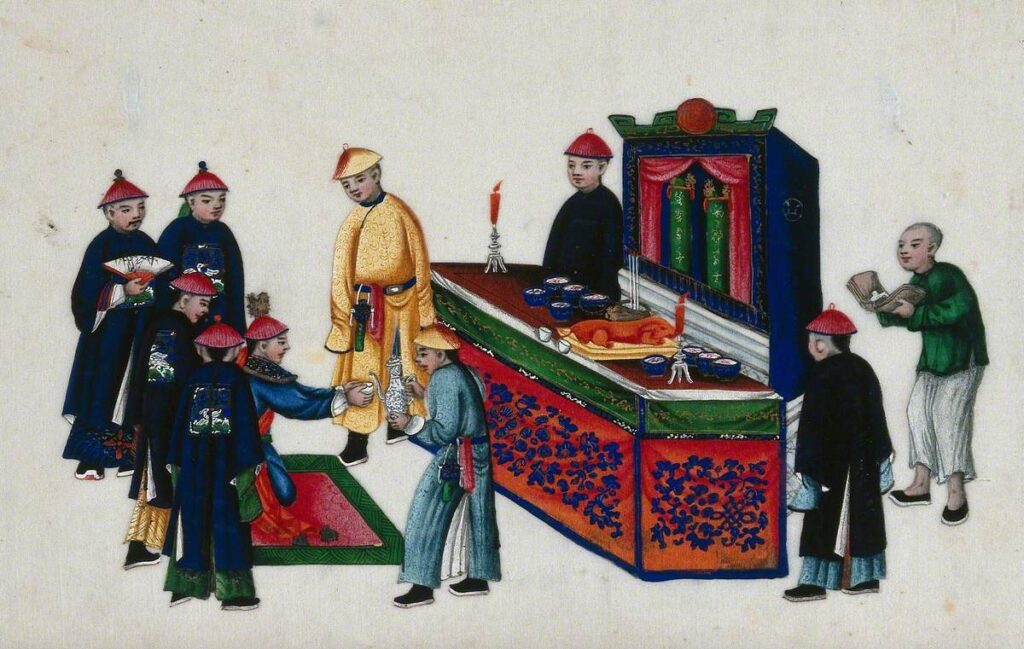
Tea was first cultivated in China, with references to its use dating from the first millennium BC. A legend attributes its discovery to the mythical emperor Shennong. Initially used as medicine, and occasionally in food, tea became popular as a beverage during the Tang Dynasty (618–907). Throughout the centuries, paintings illustrated tea’s evolving ceremonial and domestic uses, as well as its associations with respect, status and sophistication.
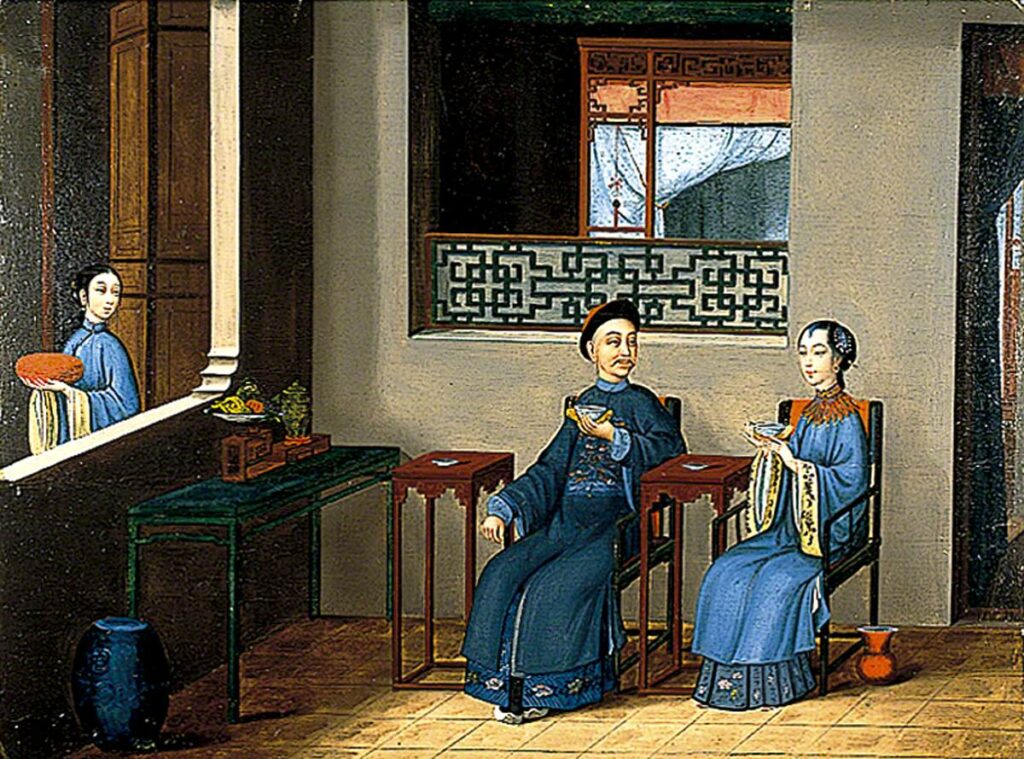
n the eighth century, tea spread to Japan via Buddhist monks. The country developed its own unique tea culture, formalising the aesthetic and philosophical ritual of the tea ceremony in the sixteenth century. Its spatial harmony and focused simplicity are evinced in a woodblock print by Mizuno Toshikata showing the ‘daily practice of the tea ceremony’.
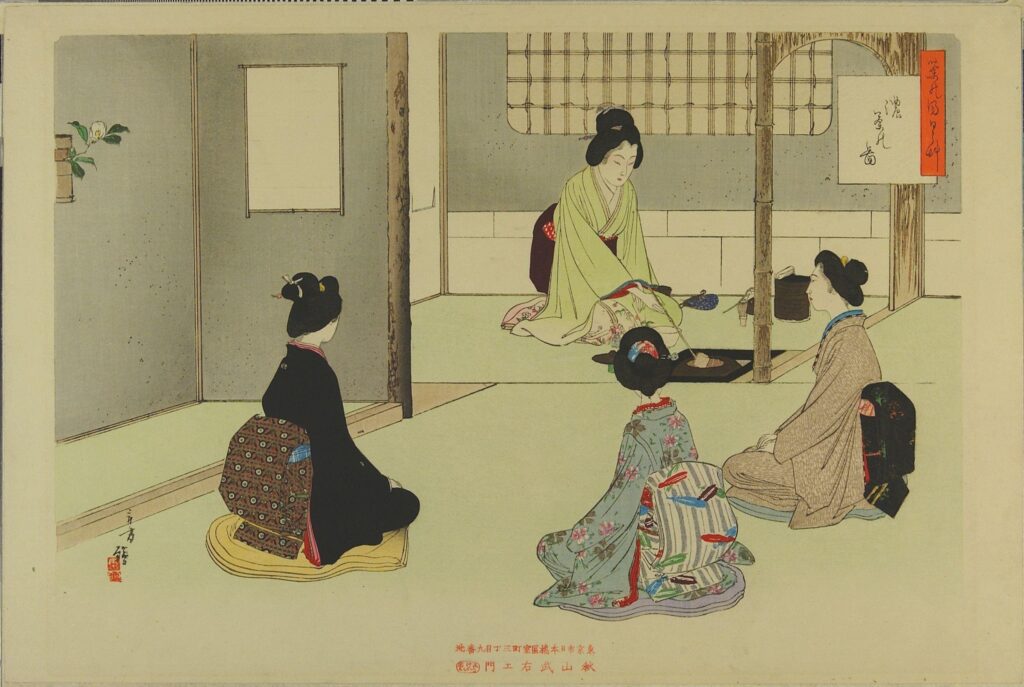
Tea and colonialism
As global trade expanded, tea arrived in Europe in the early 1600s, and in England by the 1650s. ‘The beverage soon became a necessity of life – a taxable matter,’ scholar Okakura Kazukō wrote. England’s subsequent commerce in tea lit the fuse of American independence, caused devastating social and economic effects in China, and drove the violent colonisation of India.
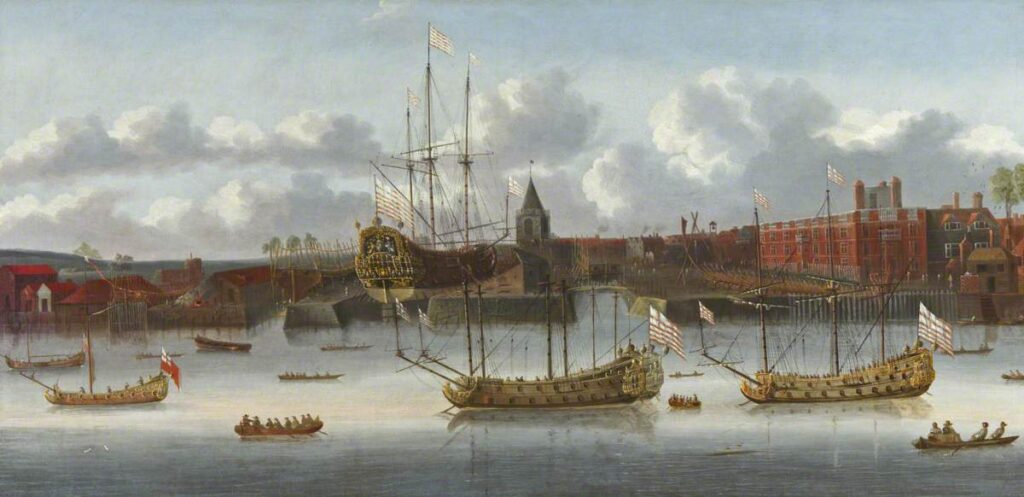
The monopolistic East India Company founded its colonial trade routes in 1600 and aggressively established commercial and then military control in India. Though chartered to join the spice trade there and in southeast Asia, they expanded their remit to transporting enslaved people from Africa and trading with China and the American territories.
At its height, tea accounted for 60 per cent of the company’s trade, and tea duties for 10 per cent of the British government’s revenue – affording the company, and tea, an extreme influence on economic and political policy.
The company’s lobbying led to a significant change in tea taxation that would give them an advantage in North American trade. In protest, American colonists held a tea party in Boston Harbour in 1773 that instigated the American War of Independence. Popular prints immortalised the scene of tea chests being thrown into the water under less-than-ideal brewing conditions.
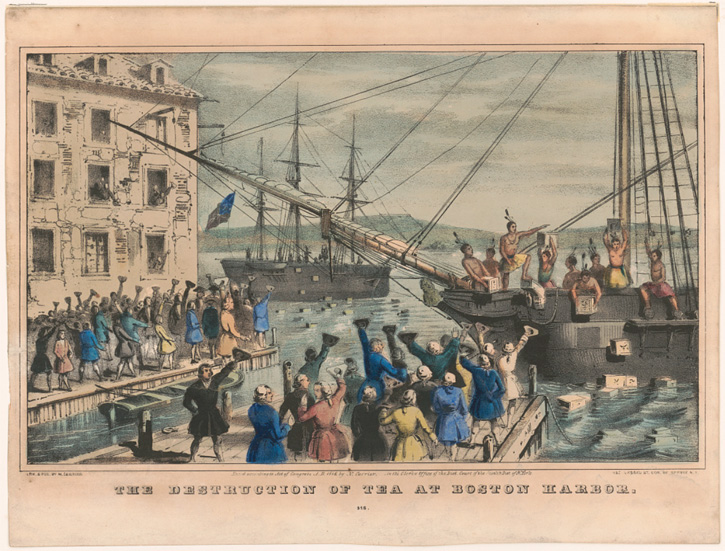
At the height of England’s tea trade with China in the late eighteenth century, figures of Chinese tea tasters stood on the parapet of a tea warehouse in Stafford, a testament to China’s dominance of the industry.
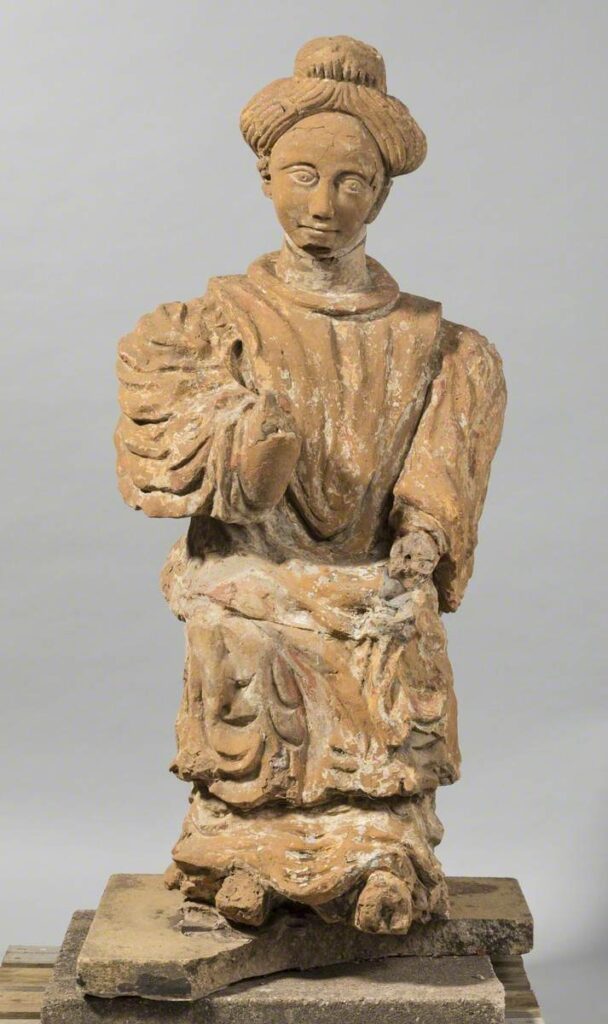
Though the British were eager to buy, they chafed at China’s strict foreign trade regulations and lack of interest in British exports, which caused a significant trade imbalance.
The East India Company decided to finance the tea trade by illegally exporting opium, triggering the mid-nineteenth-century Opium Wars when the Chinese government tried to suppress the drug. Not only did the wars cause reverberating damage to the Chinese government and economy, but the disruptions in tea supply (and the end of its monopoly in China) further determined the East India Company to develop tea plantations in Assam.
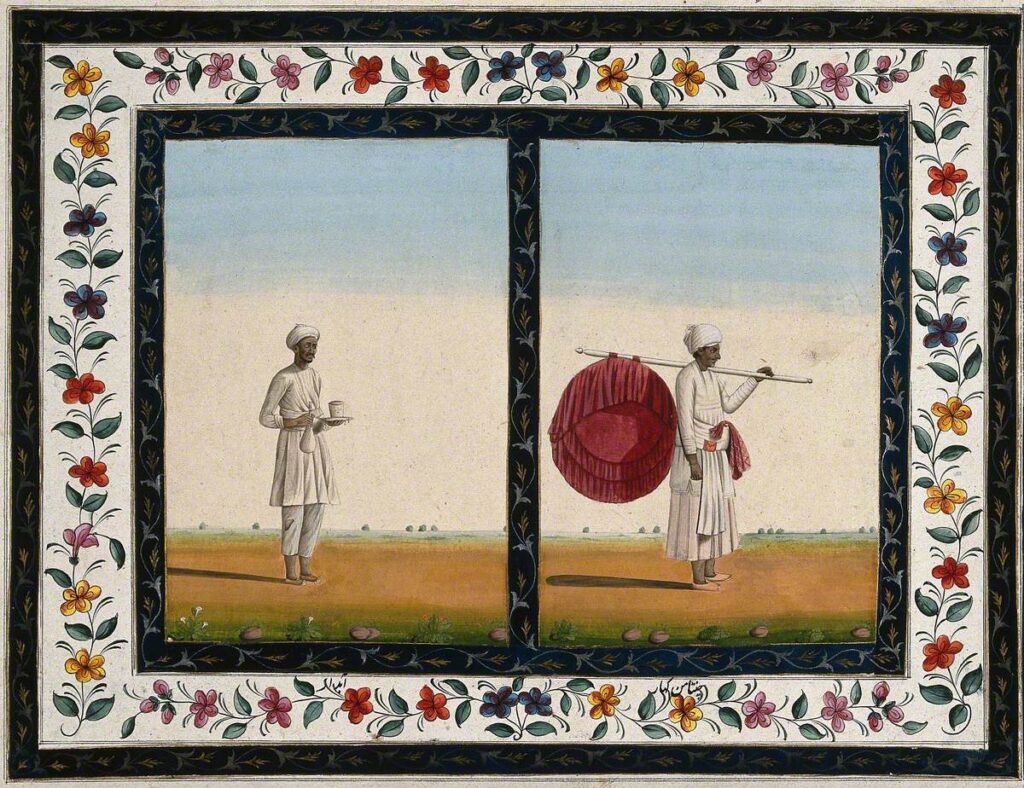
Paintings of pickers and plantations show how tea was grown, harvested, and shipped in various locales, but rarely the realities of the industry. In Assam, indentured tea labourers worked under notoriously harmful and coercive conditions. But as the industry grew across the continent, these practices were shrouded by cheery, promotional imagery of predominantly women tea-pickers in picturesque fields.
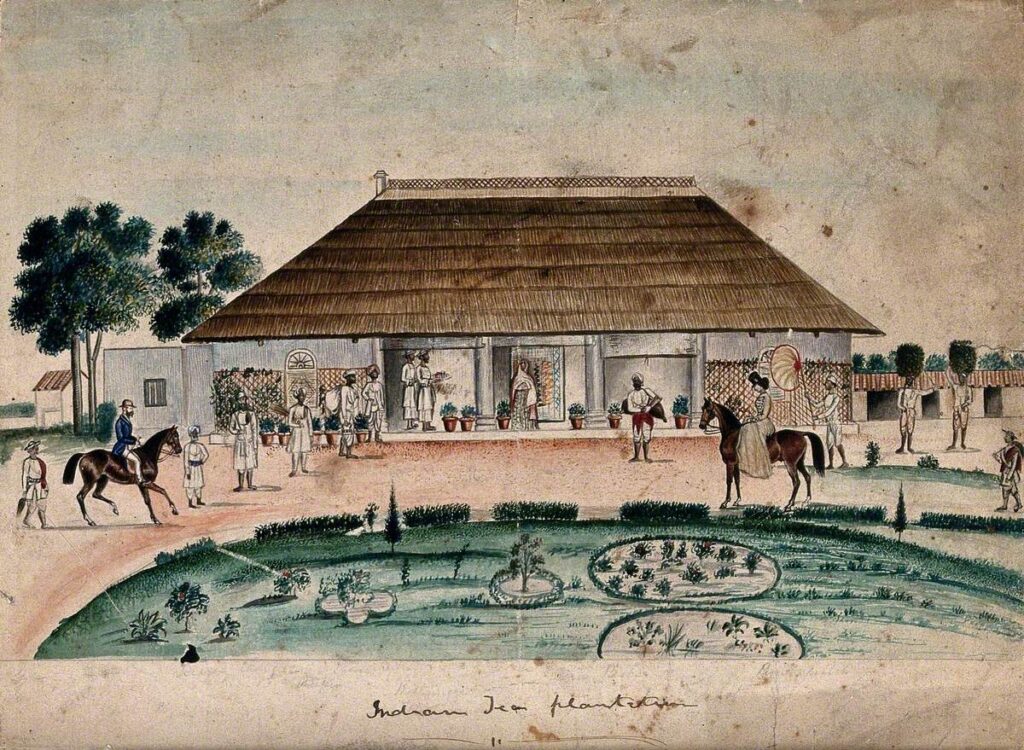
Paintings of pickers and plantations show how tea was grown, harvested, and shipped in various locales, but rarely the realities of the industry. In Assam, indentured tea labourers worked under notoriously harmful and coercive conditions. But as the industry grew across the continent, these practices were shrouded by cheery, promotional imagery of predominantly women tea-pickers in picturesque fields.
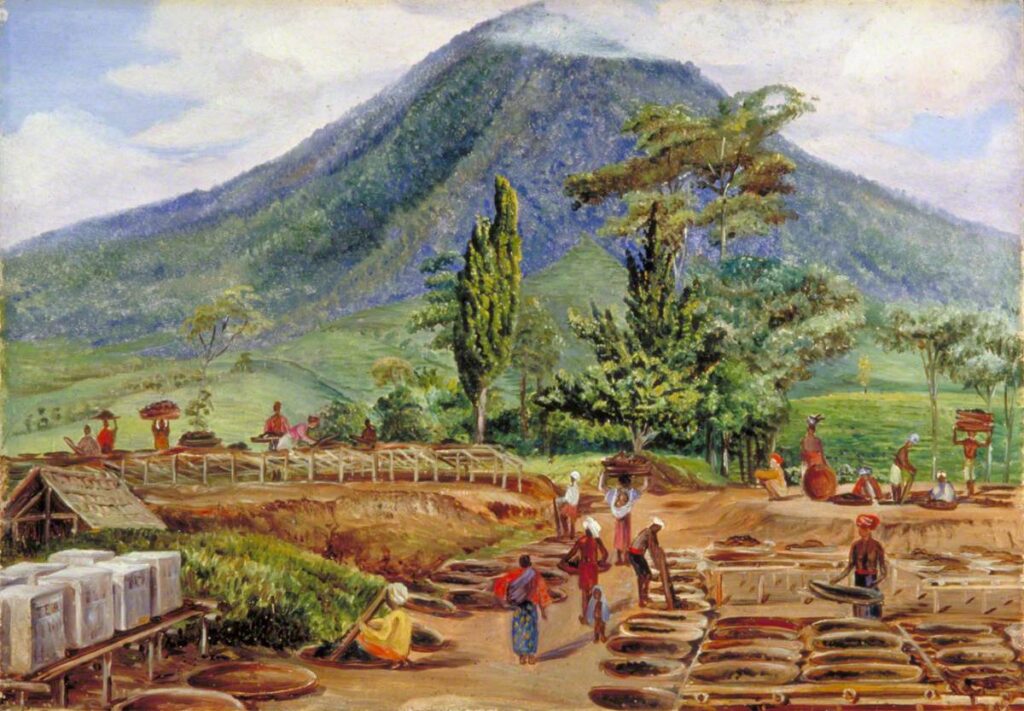
A page of languid sketches of a Tamil village and tea plantation from around 1889 centres a woman gracefully picking tea.

Flurried brushstrokes and vivid colours create more movement in Ceylonese Tea Pickers by Edward Atkinson Hornel, but the artist’s interest seems to lie more in technique than in documenting the workers’ features or conditions.
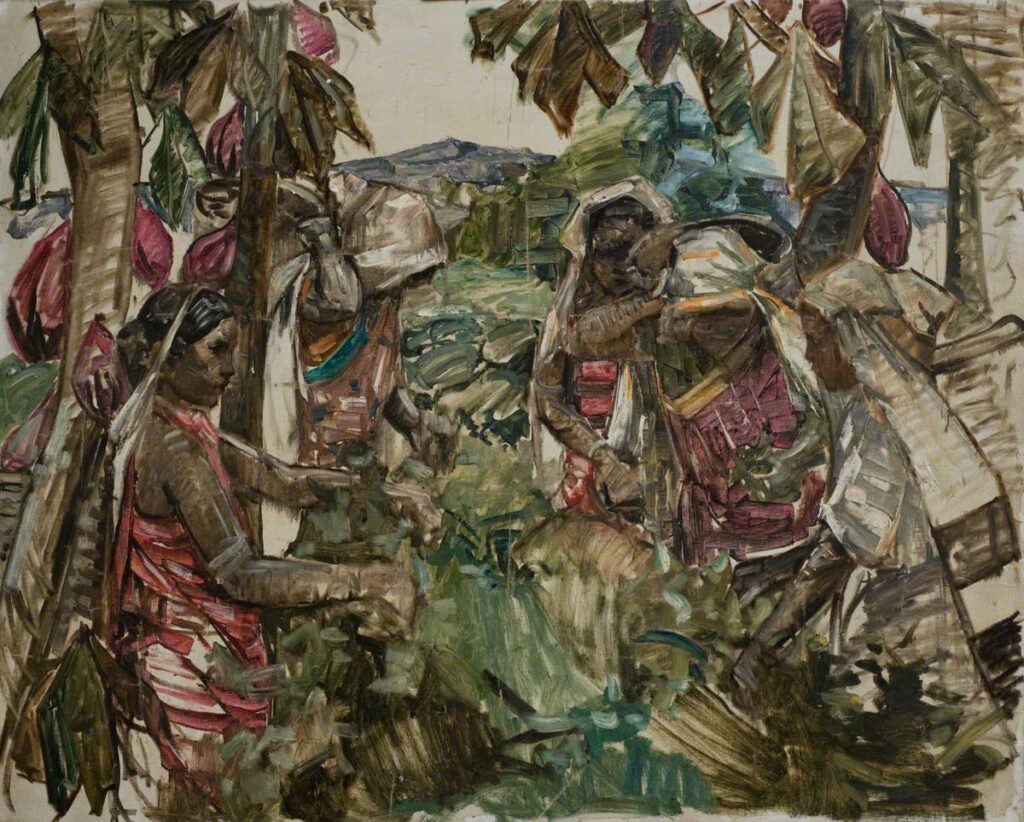
The human aspects of the tea trade were often glossed over, but numerous paintings commemorated the economic prowess and naval power that their labour built. Tea clippers like the Cutty Sark were designed for speed to meet growing demand in the nineteenth century.
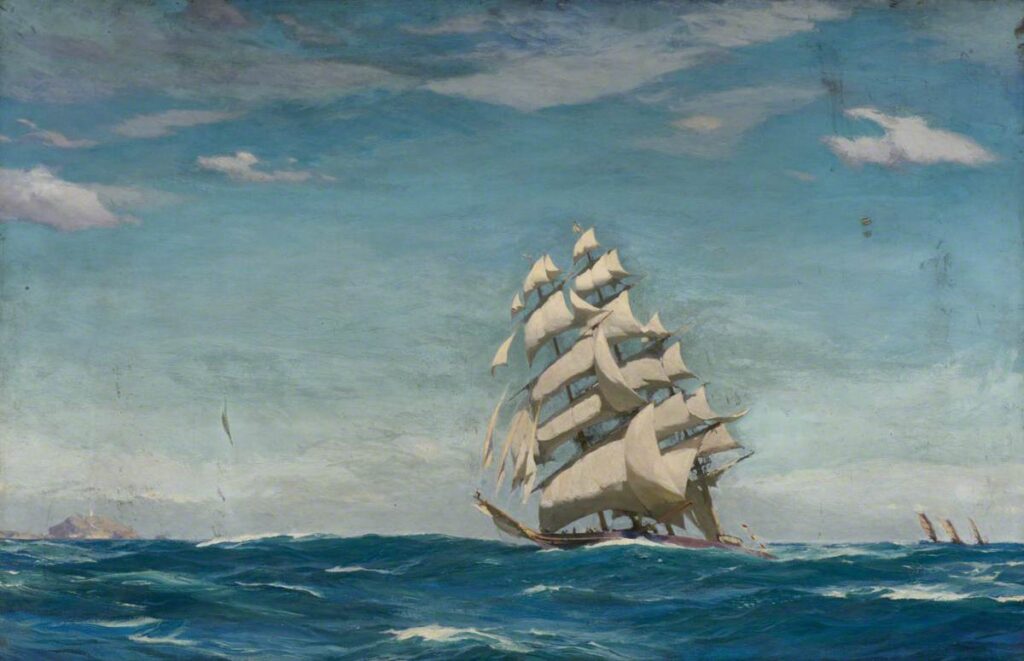
But once the tea arrived, British consumers saw only what was in their cups. Tea plantations – and the people who produced tea – were often exoticised and distanced from the domestic British imagery of tea until the twentieth century.
Original article: Art UK
To be continued









Cancel anytime


Using our website
You may use the The Middle Land website subject to the Terms and Conditions set out on this page. Visit this page regularly to check the latest Terms and Conditions. Access and use of this site constitutes your acceptance of the Terms and Conditions in-force at the time of use.
Intellectual property
Names, images and logos displayed on this site that identify The Middle Land are the intellectual property of New San Cai Inc. Copying any of this material is not permitted without prior written approval from the owner of the relevant intellectual property rights.
Requests for such approval should be directed to the competition committee.
Please provide details of your intended use of the relevant material and include your contact details including name, address, telephone number, fax number and email.
Linking policy
You do not have to ask permission to link directly to pages hosted on this website. However, we do not permit our pages to be loaded directly into frames on your website. Our pages must load into the user’s entire window.
The Middle Land is not responsible for the contents or reliability of any site to which it is hyperlinked and does not necessarily endorse the views expressed within them. Linking to or from this site should not be taken as endorsement of any kind. We cannot guarantee that these links will work all the time and have no control over the availability of the linked pages.
Submissions
All information, data, text, graphics or any other materials whatsoever uploaded or transmitted by you is your sole responsibility. This means that you are entirely responsible for all content you upload, post, email or otherwise transmit to the The Middle Land website.
Virus protection
We make every effort to check and test material at all stages of production. It is always recommended to run an anti-virus program on all material downloaded from the Internet. We cannot accept any responsibility for any loss, disruption or damage to your data or computer system, which may occur while using material derived from this website.
Disclaimer
The website is provided ‘as is’, without any representation or endorsement made, and without warranty of any kind whether express or implied.
Your use of any information or materials on this website is entirely at your own risk, for which we shall not be liable. It is your responsibility to ensure any products, services or information available through this website meet your specific requirements.
We do not warrant the operation of this site will be uninterrupted or error free, that defects will be corrected, or that this site or the server that makes it available are free of viruses or represent the full functionality, accuracy and reliability of the materials. In no event will we be liable for any loss or damage including, without limitation, loss of profits, indirect or consequential loss or damage, or any loss or damages whatsoever arising from the use, or loss of data, arising out of – or in connection with – the use of this website.
Last Updated: September 11, 2024
New San Cai Inc. (hereinafter “The Middle Land,” “we,” “us,” or “our”) owns and operates www.themiddleland.com, its affiliated websites and applications (our “Sites”), and provides related products, services, newsletters, and other offerings (together with the Sites, our “Services”) to art lovers and visitors around the world.
This Privacy Policy (the “Policy”) is intended to provide you with information on how we collect, use, and share your personal data. We process personal data from visitors of our Sites, users of our Services, readers or bloggers (collectively, “you” or “your”). Personal data is any information about you. This Policy also describes your choices regarding use, access, and correction of your personal information.
If after reading this Policy you have additional questions or would like further information, please email at middleland@protonmail.com.
PERSONAL DATA WE COLLECT AND HOW WE USE IT
We collect and process personal data only for lawful reasons, such as our legitimate business interests, your consent, or to fulfill our legal or contractual obligations.
Information You Provide to Us
Most of the information Join Talents collects is provided by you voluntarily while using our Services. We do not request highly sensitive data, such as health or medical information, racial or ethnic origin, political opinions, religious or philosophical beliefs, trade union membership, etc. and we ask that you refrain from sending us any such information.
Here are the types of personal data that you voluntarily provide to us:
As a registered users or customers, you may ask us to review or retrieve emails sent to your business. We will access these emails to provide these services for you.
We use the personal data you provide to us for the following business purposes:
Information Obtained from Third-Party Sources
We collect and publish biographical and other information about users, which we use to promote the articles and our bloggers who use our sites. If you provide personal information about others, or if others give us your information, we will only use that information for the specific reason for which it was provided.
Information We Collect by Automated Means
Log Files
The site uses your IP address to help diagnose server problems, and to administer our website. We use your IP addresses to analyze trends and gather broad demographic information for aggregate use.
Every time you access our Site, some data is temporarily stored and processed in a log file, such as your IP addresses, the browser types, the operating systems, the recalled page, or the date and time of the recall. This data is only evaluated for statistical purposes, such as to help us diagnose problems with our servers, to administer our sites, or to improve our Services.
Do Not Track
Your browser or device may include “Do Not Track” functionality. Our information collection and disclosure practices, and the choices that we provide to customers, will continue to operate as described in this Privacy Policy, whether or not a “Do Not Track” signal is received.
HOW WE SHARE YOUR INFORMATION
We may share your personal data with third parties only in the ways that are described in this Privacy Policy. We do not sell, rent, or lease your personal data to third parties, and We does not transfer your personal data to third parties for their direct marketing purposes.
We may share your personal data with third parties as follows:
There may be other instances where we share your personal data with third parties based on your consent.
HOW WE STORE AND SECURE YOUR INFORMATION
We retain your information for as long as your account is active or as needed to provide you Services. If you wish to cancel your account, please contact us middleland@protonmail.com. We will retain and use your personal data as necessary to comply with legal obligations, resolve disputes, and enforce our agreements.
All you and our data are stored in the server in the United States, we do not sales or transfer your personal data to the third party. All information you provide is stored on a secure server, and we generally accepted industry standards to protect the personal data we process both during transmission and once received.
YOUR RIGHTS/OPT OUT
You may correct, update, amend, delete/remove, or deactivate your account and personal data by making the change on your Blog on www.themiddleland.com or by emailing middleland@protonmail.com. We will respond to your request within a reasonable timeframe.
You may choose to stop receiving Join Talents newsletters or marketing emails at any time by following the unsubscribe instructions included in those communications, or you can email us at middleland@protonmail.com
LINKS TO OTHER WEBSITES
The Middle Land include links to other websites whose privacy practices may differ from that of ours. If you submit personal data to any of those sites, your information is governed by their privacy statements. We encourage you to carefully read the Privacy Policy of any website you visit.
NOTE TO PARENTS OR GUARDIANS
Our Services are not intended for use by children, and we do not knowingly or intentionally solicit data from or market to children under the age of 18. We reserve the right to delete the child’s information and the child’s registration on the Sites.
PRIVACY POLICY CHANGES
We may update this Privacy Policy to reflect changes to our personal data processing practices. If any material changes are made, we will notify you on the Sites prior to the change becoming effective. You are encouraged to periodically review this Policy.
HOW TO CONTACT US
If you have any questions about our Privacy Policy, please email middleland@protonmail.com
The Michelin brothers created the guide, which included information like maps, car mechanics listings, hotels and petrol stations across France to spur demand.
The guide began to award stars to fine dining restaurants in 1926.
At first, they offered just one star, the concept was expanded in 1931 to include one, two and three stars. One star establishments represent a “very good restaurant in its category”. Two honour “excellent cooking, worth a detour” and three reward “exceptional cuisine, worth a
Thank you for your participation,
please Log in or Sign up to Vote

123Sign in to your account